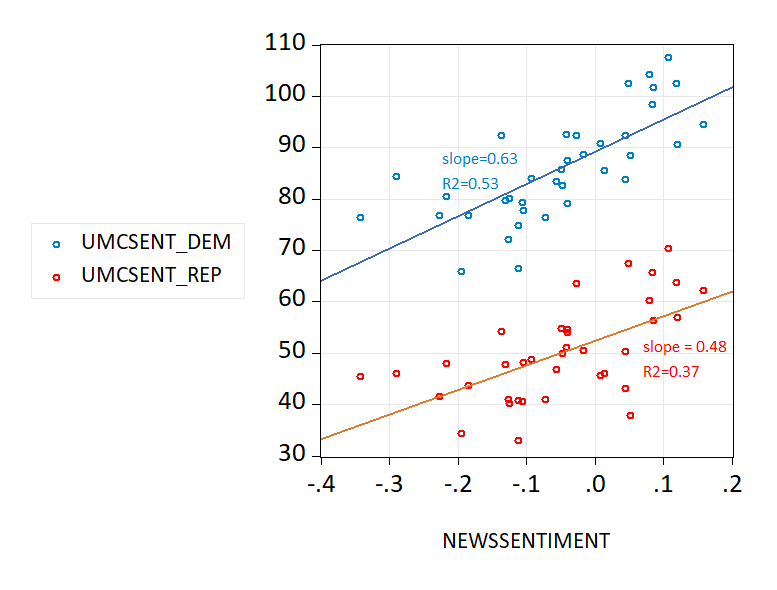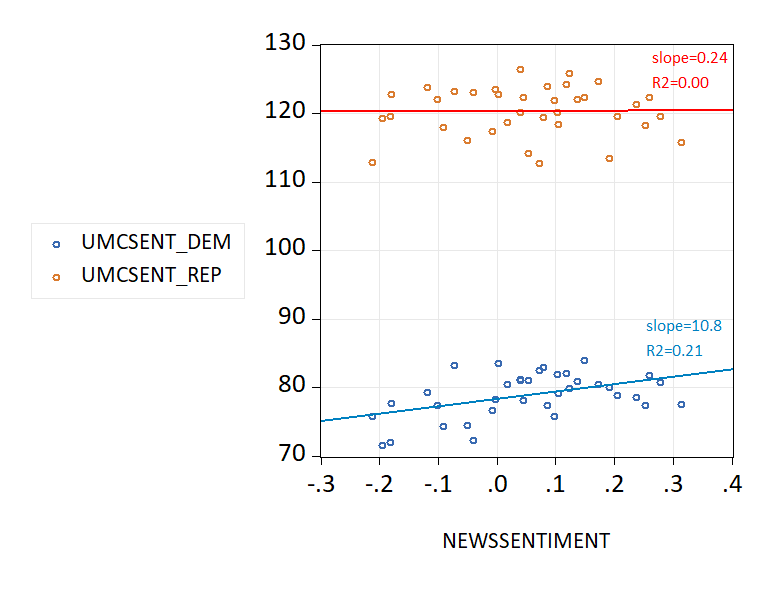How sensitive are economic sentiments as measured by the University of Michigan survey, depending upon party affiliation? Apparently, over the period of the Biden administration, it’s higher for Democrat and lean-Democrat.
Figure 1: University of Michigan sentiment by Democrat/lean-Democrat (blue circles), by Republican/lean Republican (red circles) vs. Shapiro-Sudhof-Wilson SF Fed news sentiment index, 2021M02-2024M02. OLS regression lines (slope, R2) Source: University of Michigan, SF Fed, and author’s calculations.
Not only is Democrat/lean Democrat sensitivity greater, the R2 of regression of sentiment on news sentiment is higher too. In other words, it’s a little harder to link Republican/lean Republican sentiment to a text-based news index. The constant is statistically significant, whereas the slope coefficients are not significantly different, using the 5% significance level (F-test).
I also show a nonparametric smoother (nearest neighbor, window=0.7):
Figure 2: University of Michigan sentiment by Democrat/lean-Democrat (blue circles), by Republican/lean Republican (red circles) vs. Shapiro-Sudhof-Wilson SF Fed news sentiment index, 2017M02-2024M02. Nearest neighbor fit lines (window =0.7) Source: University of Michigan, SF Fed, and author’s calculations.
Note that this relationship held even more strongly during the Trump administration, pre-pandemic:
Figure 3: University of Michigan sentiment by Democrat/lean-Democrat (blue circles), by Republican/lean Republican (red circles) vs. Shapiro-Sudhof-Wilson SF Fed news sentiment index, 2017M02-2020M01. OLS regression lines (slope, R2) Source: University of Michigan, SF Fed, and author’s calculations.
During the Trump administration, Republican/lean-Republican economic sentiment as measured by the Michigan survey was essentially completely unexplained by news sentiment as measured by the Shapiro-Sudhof-Wilson index. (The slope coefficient for Democrat/lean-Democrat is statistically significantly different from zero using HAC robust standard errors.)



I am curious about the sensitivity of politically unaffiliated respondents to new under Biden and under Trump. It is certainly interesting that one partisan groups is always more sensitive to news than the other, but the outcome of elections depends pretty heavily on swing voters – particularly in swing states.
It’s conceivable that, because they lack a party anchor, they are the most sensitive to news. There is, however, some evidence that swing voters are the least well informed voters, so they could be highly insensitive to news.
Back to the data presented here, is anyone really surprised that Republicans are more dogmatic that Democrats, less willing to admit reality when reality conflicts with their own bias? The Daily Show’s field reporting makes a point of Trump’s “family values, evangelical Christian, conservative” supporters tying themselves in knots to approve of every dispicable, radical, unethical, unchristian thing the man does.
Ruy Teixers: “The Nonwhite Working Class Bails Out on the Democrats.
These voters are now less Democratic than white college graduates.
According to the just-released New York Times/Siena poll, Biden is actually doing worse among the nonwhite working class, carrying them by a mere six points, than among white college graduates, where he enjoys a 15 point advantage over Trump. Amazing. There is perhaps no better illustration of the Democrats’ transformation into a Brahmin Left party, beloved by the educated but increasingly viewed with suspicion by the working classes of all races…
Personal assessments. Just 12 percent of the the nonwhite working class are willing to say that Biden’s policies have helped them personally. That’s actually slightly less than the 14 percent of the white working class who are willing to say the same thing. Both sectors of the working class trail white college voters, who are much higher (if hardly enthusiastic) at 28 percent on this measure.
An even starker contrast is on assessments of personal financial situation. Over half of nonwhite working-class voters describe their financial situation as only fair (33 percent) or poor (23 percent), as do white working-class voters (33 percent only fair/20 percent poor). But only a third of white college grads feel that way (27 percent only fair/just 7 percent poor).” https://www.liberalpatriot.com/p/the-nonwhite-working-class-bails
Maybe it’s time for the echo chamber here to take a look at a broader range of data…such ones that factor in income distribution and class. Just because the Top 10%, whose prosperity roughly tracks GDP growth, is doing well doesn’t automatically translate into majority of the working class feeling that it is getting ahead. (But who will tell Krugman that?)
But hey, why should Democrats bother to consider the feelings and aspirations of those deplorables into account?